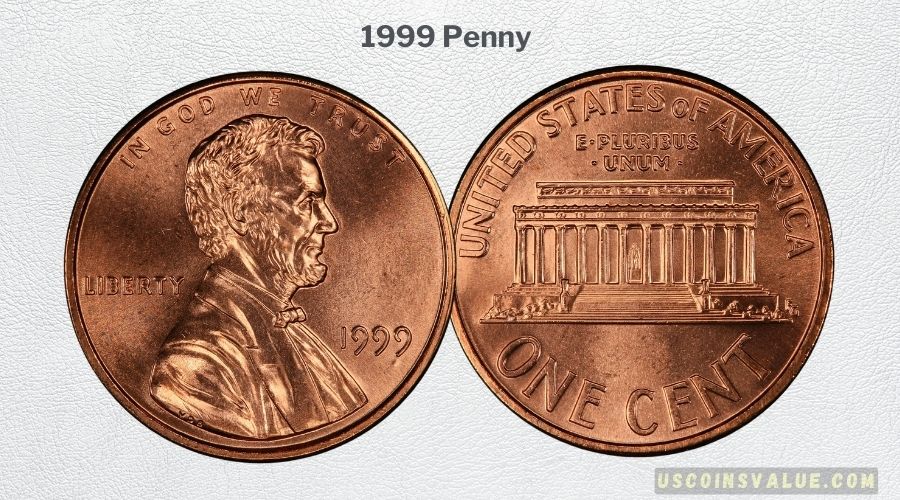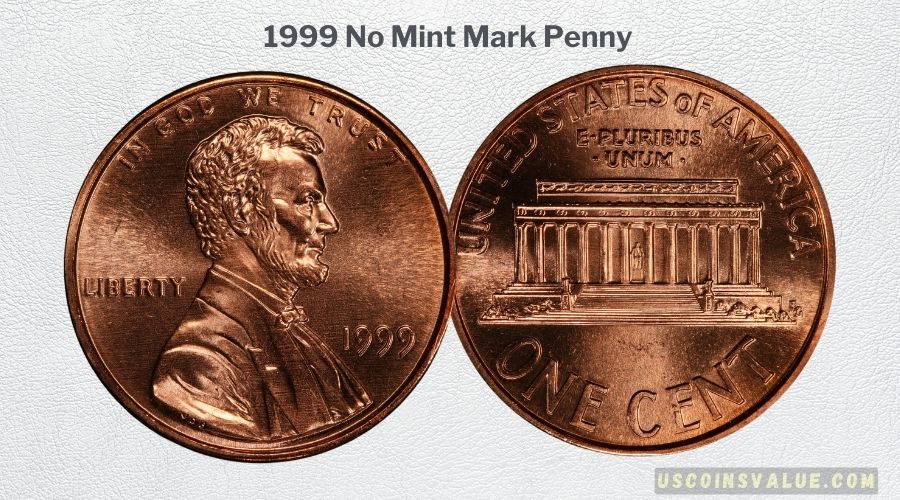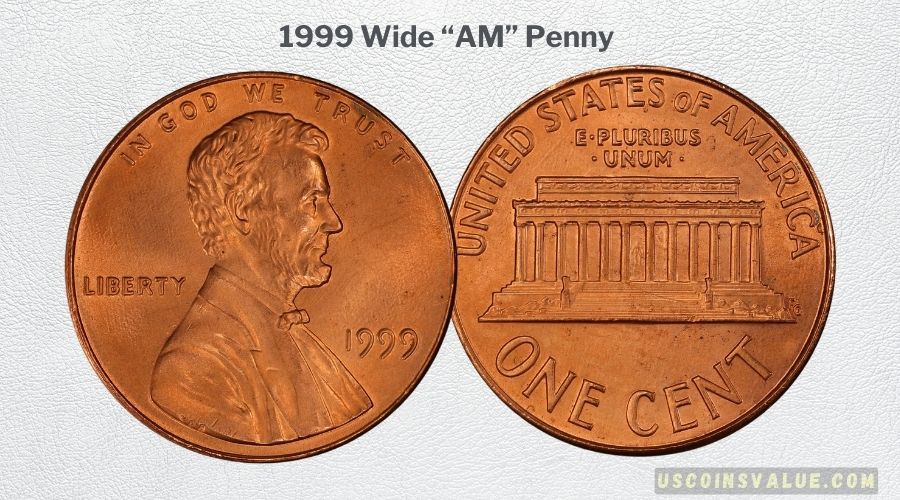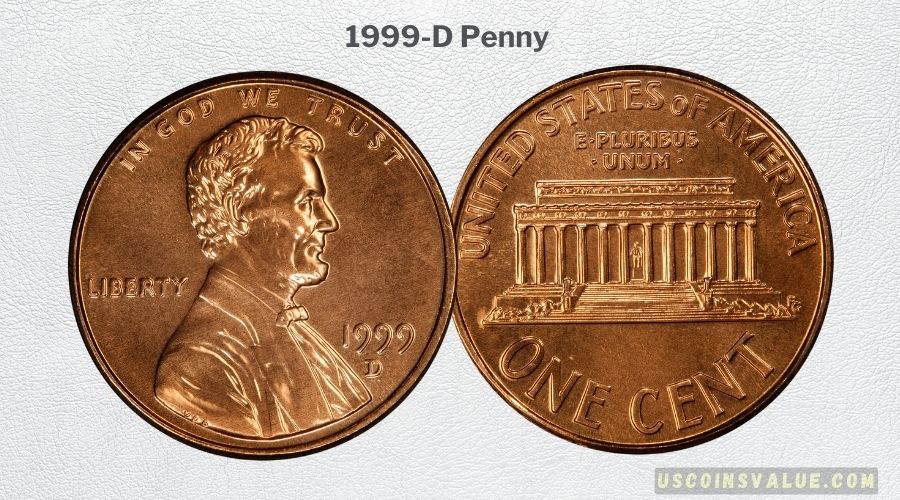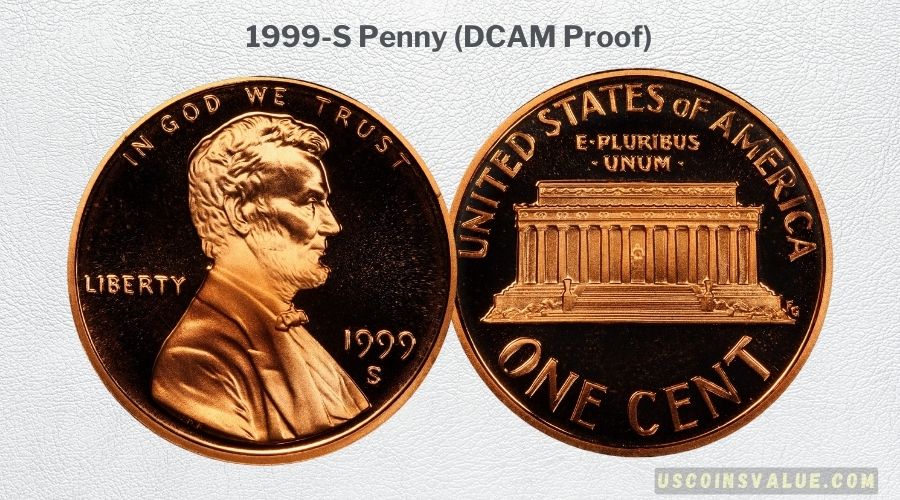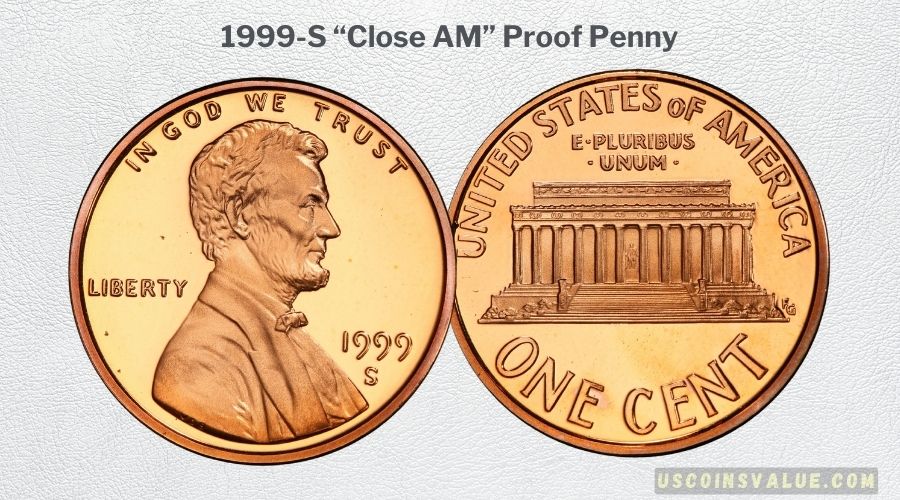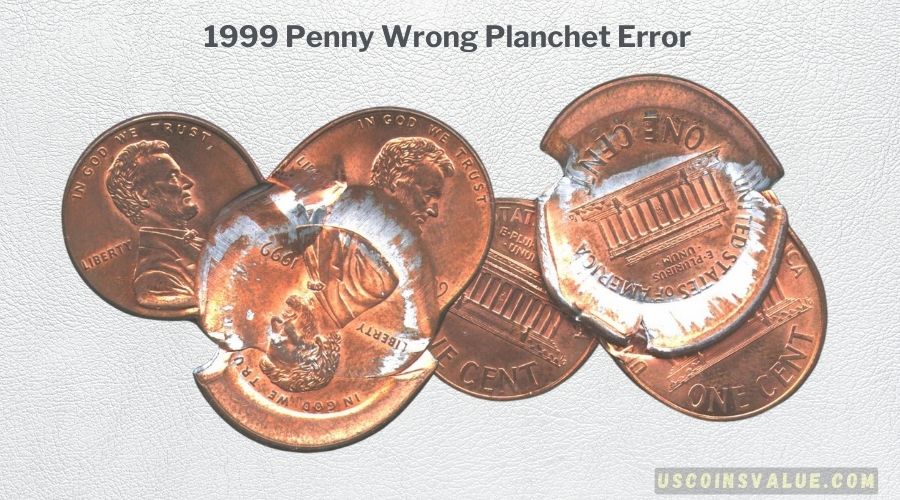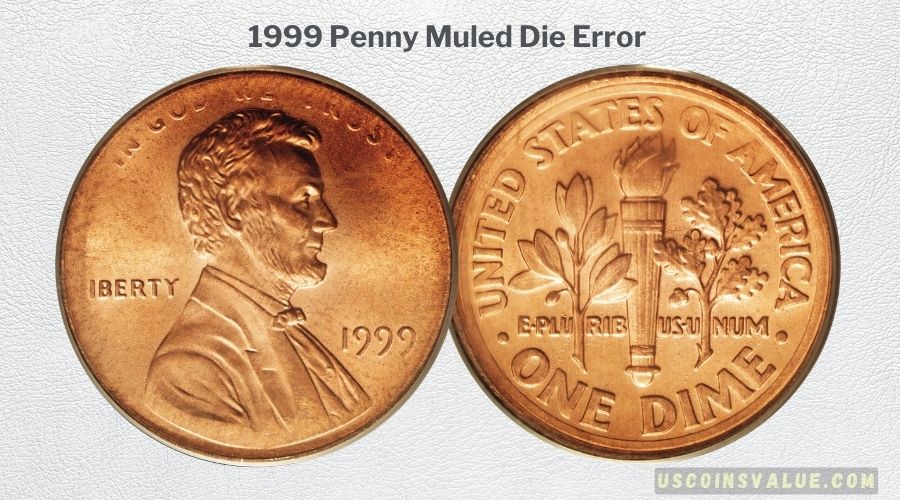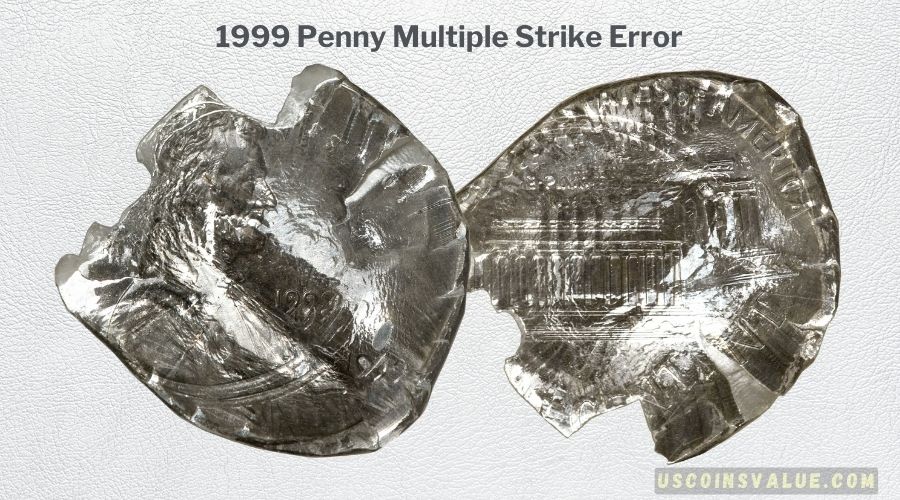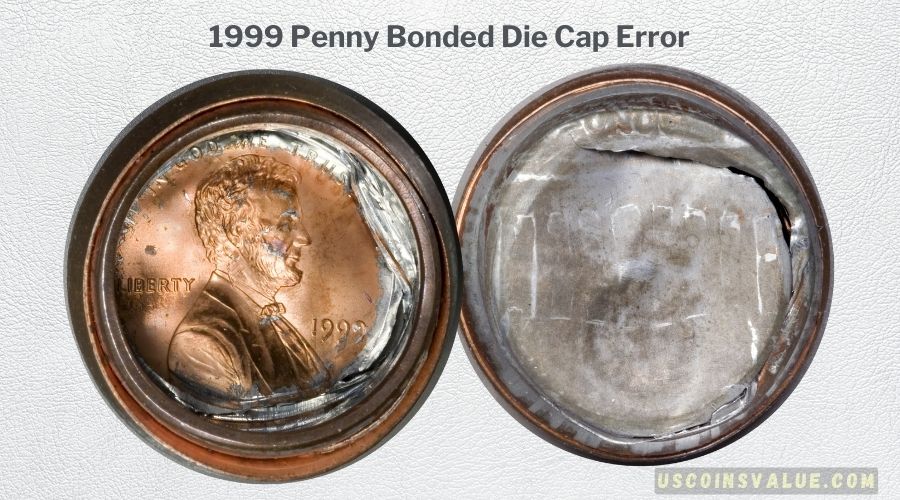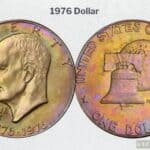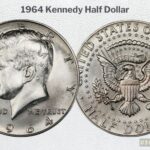Are 1999 pennies worth any value in the coin market?
Well, in 2006 a 1999 penny sold for a whopping $138,000 at an auction held by Heritage Auctions despite its muled die error. Today a regular strike 1999 cent is worth $0.38 in its uncirculated Mint State and proof variants are worth $6.81 in PF grade.
However, these prices are not set in stone. It’s vital you also know that prices can be determined by a number of factors, including
- Rarity: 1999 cents with errors are the most valuable.
- Grade: MS68 – MS69 and PR69 – PR70 grades are worth $14 – $8,500 and $14 – $10,000.
- Type: “No Mint Mark” regular strike 1999 pennies are worth more than the Proof variant except in grade PR70.
Here’s a complete guide on collecting the 1999 Lincoln to obtain the highest value.
What is the Background of the 1999 Penny?
The 1999 penny is part of the modern Lincoln Memorial series that started in 1959. It features the original obverse design from Victor Brenner and a new reverse design by Frank Gasparro.
Like other coins before 1999, this series had different dies for its business strike (regular) and proof coins. But during production, an error caused regular strike pennies to come out with proof reverses and vice versa.
This error carried on for three years between 1998 – 2000. The 1999 pennies with this unique feature are the rarest of all three.
The 1999 Penny Features: What Does it Look Like?
- Series: Lincoln Memorial (Modern)
- Year of Make: 1999
- Mintage: 5,237,600,000 | 6,360,065,000 | 3,347,966
- Mint Branch: Philadelphia
- Composition: 5% Copper and 97.5% Zinc
- Weight: 2.5 g
- Diameter: 19 mm
- Edge: Plain
Obverse & Reverse Design: What Does the 1999 Penny Look Like?
The Brenner Obverse features a right-side profile of Abraham Lincoln from his head to his upper chest. He’s wearing a classic American suit, shirt, and bow tie with his curly hair cut low. Other details on the field include:
- LIBERTY
- IN GOD WE TRUST
- 1999
- Mint Mark: “S” for San Francisco or “D” for Denver beneath the year.
On the reverse, you’ll see Frank Gasparro’s design of the Lincoln Memorial building in the center. Other details, including his initials at the lower right corner of the building’s steps, are:
- UNITED STATES oF AMERICA
- PLURIBUS.UNUM.
- “FG”
- ONE CENT
What are the 1999 Penny Varieties?
Although this table shows five variants, there are three main types of 1999 Pennies. As you’ll soon learn, the other two are subtypes of two variants. Firstly, here are all five 1999 pennies at a glance.
| 1999 (Lincoln Memorial) Penny Varieties | Mint Location | Mintage |
| No Mint Mark | Philadelphia | 5,237,600,000 |
| Wide AM | ||
| D Mint Mark | Denver | 6,360,065,000 |
| S Mint Mark (DCAM Proof) | San Francisco | 3,347,966 |
| S Mint Mark (Close AM) Proof |
1. 1999 “No Mint Mark” Penny
Every 1999 penny from the Philadelphia Mint had no mint mark because that was the primary facility of the USA. Surprisingly, it’s not the highest mintage of the coin but comes a close second to the Denver mint at almost 5.3 billion.
A standard 1999 “no mint mark” penny comes in red (RD), brown (BN), red-brown (RB) and has all the features listed above. But another variant exists because of an error in the details on the reverse.
Usually, the letters in “UNITED STATES oF AMERICA” are closed, but some came with a space between “A” and “M”.
1999 Wide AM Penny
The 1999 Wide AM penny is a sub-variant of the “no mint mark” penny. It’s a set of one-cent coins from the Philadelphia Mint with a space between the “A” and “M” in “America” on its reverse side.
Sadly, there’s no record of the exact amount of coins that came out with this error. But the 1999 Wide AM pennies in circulation today are more valuable than the ones with the normal small AM.
2. 1999-D Penny
The 1999-D penny came from the Denver Mint and had the standard three colors of red (RD), brown (BN), red-brown (RB), and a fourth shade, red prooflike (RD PL). The RD PL 1999-D penny is a shinier, earthy red with clearer details like a Proof coin.
It has the same copper-plated zinc composition as the other variants and has the highest mintage at over 6.3 billion.
3. 1999-S Proof Penny
San Francisco exclusively produced the 1999 Proof pennies in two standard colors — Red-Brown and Deep Cameo (DCAM). The DCAM coins had a unique manufacturing style that required fresh dies and planchets to give the coin a shiny luster.
That’s why, years later, they still look brand new. The 1999 Proof pennies had the least mintage of all three variants at barely 3,347,966. They also have two types, but there’s no info on the exact mintage of each 1999-S Proof penny variant.
It’s the most valuable variant in the highest grade (PR70).
4. 1999-S DCAM penny
A standard 1999-S Proof penny has a DCAM luster that makes it come out with a dual tone. The field has a deep black hue, while the details are shiny copper. On the reverse, you’ll see a spaced “AM” on the upper arch reading “UNITED STATES oF AMERICA.”
5. 1999-S Close AM penny
The 1999-S “Close AM” penny results from using a regular strike die on the reverse side of a Proof cent. So, instead of the standard spaced “AM” in “UNITED STATES oF AMERICA”, you’ll see the letters hurdled together.
Why is the 1999 Penny Special?
The 1999 penny has many coins with rare errors, including the Wide AM “no mint mark” variant and 1999-S DCAM proof pennies. Regular strike 1999 pennies came with a closed “AM” on the reverse, while the Proof coins had a wider style.
So, when the production uses the wrong die on a 1999 penny’s reverse, you’ll get a rare error. The two common variants are the Wide AM regular strike 1999 penny and the Close AM 1999-S Proof penny.
Also, the 1999 penny is the last year of the 20th century, so it holds sentimental value to that age.
How to Determine the Grade of a 1999 Penny
Note: We’re not professional coin graders and this guideline isn’t an official confirmation of your coin’s grade.
Here we’ll show you how to grade your coins from home.
The universal coin grading uses the Sheldon scale, ranging from 1 – to 70. It started in the 1940s and has carried on until now. Besides the numbers, there’s also a two-letter code used to identify the physical quality of your coin.
The highest and most valuable grades are MS (Mint State) for regular strikes and PR or PF (Proof) for Proof coins. Coin grades between 60 – and 70 on the Sheldon scale are MS or PF/PR, depending on the type.
| Grade MS/PF/PR | Qualities |
| 60 | Marks on the surface with poor detailing from weak strike but no wear. |
| 61 | Scratches on the surface with average strike detailing but no wear. |
| 62 | Slight marks on parts of the surface with weak strikes but visible details. |
| 63 | Hairlines across the field with little to no abrasions |
| 64 | Barely visible imperfections including hairlines and scratches. You’ll need a magnifying glass to see them. |
| 65 | Clear struck details with faint hairlines and marks. |
| 66 | Boldly struck details with slight hairlines and marks lesser than an MS65 coin. |
| 67 | Sharp details from clear strike (very common) |
| 68 | Sharp details with almost zero imperfections. You’ll need a large magnifying glass to spot them. |
| 69 | Almost brand new coin with invisible imperfection unless scrutinized by professionals. |
| 70 | Zero imperfections. Good as new and looks freshly-minted. |
What’s the Current Value of the 1999 Penny?
You can find all valuable 1999 “no mint mark” pennies in Mint State 60 until 69. For 1999-D pennies, the value starts from MS63 and ends in MS69. Meanwhile, all Proof pennies are valuable from PR 60 – PR 70!
In today’s market, the 1999 “no mint mark” penny with the Wide AM variant is worth at least $90 in an MS60 grade and up to $8,500 for an MS69 grade. The next worthy type is the 1999-S Proof cents, especially in Close AM error.
| 1999 Penny MS/PR | 1999 “No Mint Mark” and Wide AM Penny | 1999-D Penny | 1999-S (Close AM) and DCAM Proof Penny |
| 60 | $90 – $130 | – | $1 |
| 61 | $100 – $140 | – | $1 |
| 62 | $110 – $150 | – | $1 |
| 63 | $7 – $180 | $6 | $2 – $45 |
| 64 | $10 – $215 | $7 | $3 – 54 |
| 65 | $4 – $285 | $8 | $4- $70 |
| 66 | $5 – $450 | $10 – $12 | $5 – $84 |
| 67 | $10 – $1,450 | $24 – $32 | $6 – $100 |
| 68 | $14 – $1,800 | $60 – $95 | $7 – $150 |
| 69 | $8,500 | $425 | $14 – $215 |
| 70 | – | – | $42 – $10,000 |
1. 1999 No Mint Mark Penny
In 2023, Heritage Auctions sold 1999 pennies with no mint mark for $124, $139, and $192 between March and April. That’s way less than the auction record of $138,000 it set for this variant in 2006.
The eBay sales were even lower at $10 – $45 between August and September, 2023. But in June of the same year, an MS63 1999 no-mint mark penny sold for $250, and an MS66 piece sold for $685 on the platform.
| Grade | Highest Price & Sale Date | Firm |
| MS66 | $138,000 (2006) | Heritage Auctions |
| MS65 | $1,725 (2003) | Superior Galleries |
| MS63 | $1,668 (2002) | Heritage Auctions |
| Ungraded | $1,380 (2008) | Heritage Auctions |
| MS65 | $1,265 (2003) | Bowers & Merena |
2. 1999 Wide “AM” Penny
The 1999 “Wide AM” penny had some of its best sales in 2019 from eBay to auction firms. Heritage Auctions sold an MS67 grade for $1,260, eBay sold for $1,597.45, and Legend Rare Auction Coins sold the same grade for $1,292.50.
This year, buying an MS67 – MS70 grade off eBay is cheaper as it’ll cost you between $10 – $41.
Heritage Auctions sold an MS68 grade for $192 in April 2023, and an MS66 graded 1999 Wide AM penny sold for $685 on eBay. The auction record for this variant is $4,583 in a recent sale by Legend Rare Coin Auctions in 2020.
| Grade | Highest Price & Sale Date | Firm |
| MS68 RD | $4,583 (2020) | Legend Rare Coin Auctions |
| MS68 | $3,960 (2020) | Heritage Auctions |
| MS67 | $2,300 (2011) | David Lawrence RC |
| MS67 | $2,128 (2007) | Heritage Auctions |
| MS67 RD | $1,600 (2021) | eBay |
3. 1999-D Penny Value
The 1999-D penny is the least valuable variant because it has no unique feature to drive demand. Its auction record is $1,293 for an MS69 grade in 2013 by Heritage Auctions. Only eBay sold this variant for an average of $13 – $80 in 2023.
| Grade | Highest Price & Sale Date | Firm |
| MS69 | $1,293 (2013) | Heritage Auctions |
| MS69 | $1,163 (2008) | Heritage Auctions |
| MS68 | $978 (2011) | Heritage Auctions |
| MS69 | $920 (2005) | Heritage Auctions |
| MS69 | $705 (2014) | Heritage Auctions |
4. 1999-S Penny Value (DCAM Proof)
Lately, the DCAM 1999-S Proof penny hasn’t been lucrative on the open market. Auction firms recorded sales of this variant last in 2020. So, sales in the last three years happened via resellers on the internet.
This 2023, only eBay recorded sales of 1999-S DCAM Proof pennies and they’ve been very low. An October sale of a PR69 DCAM grade realized $5 while a July sale made $9 and $42. The auction record stands at $2,358 for a PR70 grade by Heritage Auctions in 2004.
| Grade | Highest Price & Sale Date | Firm |
| PR70 | $2,358 (2004) | Heritage Auctions |
| PR70 | $863 (2007) | Bowers & Merena |
| PR70 | $748 (2005) | Heritage Auctions |
| PR69 | $431 (2005) | Heritage Auctions |
| PR70 | $546 (2005) | Heritage Auctions |
5. 1999-S “Close AM” Proof Penny
Since the 1999-S “Close AM” Proof penny is the rarer variant, it’s more valuable than its counterpart. 2023 recorded high sales, like $552 for a PR69DCAM grade by Heritage Auctions in April and $250 for an RD shade in March.
The auction record is $1,035 for a PR69 grade 2008 by Heritage Auctions. Other high sales realized include:
| Grade | Highest Price & Sale Date | Firm |
| PR69 | $1,035 (2008) | Heritage Auctions |
| PR69 | $949 (2009) | Heritage Auctions |
| PR69 | $863 (2010) | Heritage Auctions |
| PR68 | $805 (2007) | Heritage Auctions |
| PR69 | $489 (2009) | Heritage Auctions |
Common Errors You’ll Find in 1999 Penny
Besides the popular “Wide AM” and “Close AM” errors that have become variants of the 1999 penny, here are other mistakes that can increase the value of your coin.
- Wrong Planchet Error
- Muled Die Error
- Multiple Strike Error
- Bonded Die Cap Error
1. Wrong Planchet Error
A planchet is a plain surface upon which a strike produces details that turn it into a coin. Every denomination has a designated planchet size. Using the wrong planchet would make an ill-fitted coin. That means you’ll see features of other currencies on your coin.
A typical example is a 1999 penny struck on a dime planchet. Heritage Auctions sold a 1999 1C coin struck on a 10C planchet for $863 in 2007 and a 1999 penny struck on three planchets sold for $1,668 in 2002.
2. Muled Die Error
When two wrong dies mix, it’s called a mule. It can happen on the reverse, obverse, or collar. That means a 1999 Proof die can combine with a 1999 Susan B. Anthony dollar die. This error gives the coin an odd color and often missing details like dates and mint marks.
It’s a rare error, though, which is why a 1999 1C Lincoln coin with an obverse die muled with a Roosevelt Dime Reverse graded MS66 holds the auction record at Heritage Auctions for $138,000.
3. Multiple Strike Error
Every coin needs a single strike for complete details. A planchet shift or faint die causes a weak strike, which leads to a second, third, or even fourth strike to get the details.
This error results in having duplicated details on the obverse or reverse. In 2014, this triple struck 1999 1C coin graded MS63 by ANACS sold for $2,585 at Heritage Auctions.
4. Bonded Die Cap Error
If a coin’s strike passes through another coin, it causes a bond called a “bonded pair.” The part of the “wrong coin” that fuses with the intended coin is then referenced as the “die cap.” Hence the error, bonded die cap.
In 2008, Heritage Auctions sold a 1999 one cent coin with two pieces bonded die caps for $1,380.
Final Thoughts
The 1999 penny is an interesting piece of history mainly because of its unique features. It’s understandable why coin collectors demand this series more than 20 years after its release.
New numismatics should start small by collecting the 1999-D penny variant, as it’s the most affordable. Experienced collectors can search for the 1999 “Wide AM” and 1999-S “Close AM” Proof pennies.
Always remember to grade your coin before trading to get the best value.

